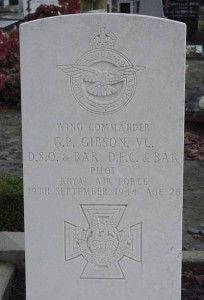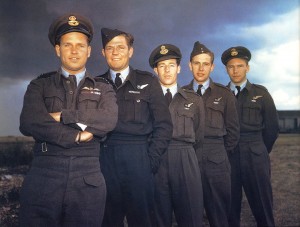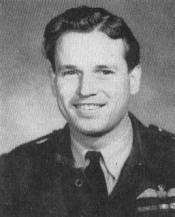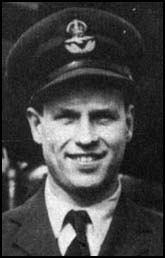Wg Cdr Guy Gibson RAF VC
GUY PENROSE GIBSON
Killed in Action 19th September 1944 Aged 26, Steenbergen, Holland
Born 12th August 1918, Simla, India
Many people will wonder what the leader of the famous `Dambusters Raid` has to do with the Borough of Helston?
Quite simply, his mother Nora Strike, the daughter of Sea Capt. Edward Strike, was born in Porthleven and Guy spent sometime in the village as a young boy.
GUY PENROSE GIBSON
VICTORIA CROSS
DISTINGUISHED SERVICE ORDER & BAR.
DISTINGUISHED FLYING CROSS & BAR
WING COMMANDER, ROYAL AIR FORCE
Mr Bert Cowls, a very good friend of my Grandfather W.F. Ivey, knew Guy Gibson as a friend when they were young boys in Porthleven and wrote about him his
“Looking Back to Yesterday” (Bygone days in a Cornish Fishing Village)
Mr. Cowls wrote the following:
“One day, Father announced we were going to have a lodger. He had met Mr. Alexander Gibson, who was staying at Sunny Bank and wanted to lodge at Breageside. Great preparations were made at home, for this gentlemen was a Civil Servant holding a government position in India. He had the – best two rooms in the house, and a piano was hired. This seemed wonderful – I doubt if there was half-a-dozen pianos in the whole village at that time.
Further up the road from us lived a Capt. Edward Strike, a sea captain who had a very pretty daughter. She had a lovely voice, and took part in classical concerts. A romance began, with Mr. Gibson soon falling in love with this attractive young woman, and culminating in wedding bells.
The wedding was one of the most attractive spectacles ever seen in the village. The male guests wore morning dress complete with top hats. The bride wore a lovely silk gown. One can vividly picture the scene – an open carriage with the bride and her father, pulled by a pair of chestnut horses resplendent with rosettes and silk ribbons. The lovely bridesmaids wearing floral dresses completed the colourful scene.
Money was no object, everything had to be of the very best. On reaching Fore Street, the carriages pulled up at the Wesleyan Chapel where the service was being held. Crowds lined the streets to catch a glimpse of the ‘ happy couple as they left the church. The red carpet was laid at the reception, and the champagne flowed.
My sister and her friends talked about this grand occasion for a long time afterwards. The former Nora Strike and her new husband left for India after their honeymoon.
About six years later, Father received a letter from Mr. Gibson, saying that his three children and their Nanny were returning to England, and could we accomodate them at South View? We welcomed the overseas family at our home – Alex, the eldest boy, Joan and Guy, the youngest. They fitted in well with our family life. Many hours were spent picnicking, swimming and fishing in the rock pools nearby.
Guy was a mischievous, though very likeable boy, and we were all very fond of him.”
“I served in the Royal Air Force in the last war, but never caught up with Guy in my movements. On the evening of May 17th, in the Sudan, we were holding the inaugural dinner, at the Grand Hotel, of the Khartoum Cornish Association, when the Sudanese newsboys delivered the evening paper.
The banner headlines told of Guy Gibson’s marvellous feat in breaking the Ruhr Dam. The story of that achievement has been well told in the history books of the Great War.
Nineteen Lancaster bombers of the famous 617 Squadron were led by 24 year old Wing Commander Gibson. Without a doubt, but for Guy Gibson’s coolness and gallantry in staying over the target areas, and controlling each bomber’s attack, the operation would not have been as
successful as it was. Of the 19 bombers engaged in the sortie, only eleven returned. For this latest operation, Guy Gibson was awarded the Victoria Cross. He was now one of the most decorated heroes of the war.
In the triumph of his success, he came back to Porthleven for a quiet spell of leave where his boyhood memories lingered.
There is little to tell of his last flight. He took off in a Mosquito to act as he master bomber and guide on a raid on a factory target in Germany. When the raid was over, the other pilots heard Gibson’s voice on the R/T saying “O.K. chaps, that’s fine, now beat it home!” But Gibson never reached England. His plane crashed in a sugar-beet field near the town of Steenbergen, in Holland, close to the Belgian border. His broken body, and that of his navigator, J.B.Warwick, were recovered and interred in Steenbergen cemetery. A Roman Catholic priest and a Protestant minister conducted the graveside burial service; a wooden cross was placed on each grave.
Later, the Imperial War Graves Commission put up two headstones.
A few years ago, I visited this Dutch cemetery, and read the inscriptions on the tombstones of these brave men. I looked particularly to see if Guy’s Cornish name of Penrose was mentioned for Guy was proud of his second Christian name. It was there, but only marked with the letter”P.”

G.P. GIBSON, V.C. D.S.O. & BAR, D.F.C & BAR
PILOT, ROYAL AIR FORCE. 19th SEPTEMBER 1944 AGE 26
Before I left, I planted a sprig of heather from a Cornish cliff on the grave.
Eye-witness Mr. Joseph Israelsster told me the story of that tragic place night. At the time, he was sixteen years of age, and on seeing the burst of flame, and hearing the explosion from the crash, he cycled to the scene of the disaster. Among the charred remains of the aircraft, they recovered two
bodies. The only identification of the pilot was a sock on one of his feet reach marked “Guy Gibson.” Under German occupation, the rule was that enemy bodies were to be buried in the nearest cemetery, and it was not until the war was over that the local inhabitants learned the real identities of the two airmen they had buried.
On asking why they were not interred in the British War Graves cemetery in Holland, I was informed that Guy’s father, and the local people, had expressed a wish that the two bodies should not be disturbed but left to lie near where they had fallen.
From the wreckage of the plane, Mr. Israelsster gathered some pieces of twisted metal, from which he made a signet ring as a precious memento of that sad day.
On September 19th 1974, just 30 years after Guy Gibson’s death, a memorial service was held at Steenbergen, and a plaque was unveiled by Air Marshal Sir Harold Martin, better known as “Micky Martin,” who piloted one of the aircraft in the front section to attack the Dams, together with Guy Gibson. At the conclusion of the service, the only remaining airworthy Lancaster of the R.A.F, flew past in salute.
On that same date, a Battle of Britain Commemorative Service was held in Porthleven, which was followed by a wreath-laying ceremony at the War Memorial on the hillside overlooking the harbour, and Guy’s boyhood home.
A street named ‘Gibson Way’ in the village, is planted with trees in memory of the pliant young serviceman, who died in the prime of life.”
BERT COWLS “Looking Back To Yesterday” 1982
Guy Gibson`s Service History:
Joined the RAF in August 1936
Transferred to Yatesbury 16th November 1936
No 24 Depot 31st January 1937 — Promoted to Acting Pilot Officer
No 6 Flight training school 6th February 1937
83 Squadron 4th September 1937
Promoted to Flying Officer 16th June 1939
Awarded DFC 9th July 1940
No 14 Operational training unit 26 September 1940
Promoted to Flight Lieutenant 3rd September 1940
No 16 Operational training unit 10th October 1940
29 Squadron 13th November 1940
Promoted to Acting Squadron Leader 29th June 1941
Awarded Bar DFC 16th September 1941
No 51 Operational training unit 23rd December 1941 — Promoted Temporary Squadron leader 1st December 1941
No 51 Group Headquarters 23rd March 1942
Promoted to Squadron Leader 13th April 1942
106 Squadron 13th April 1942
Promoted to Acting Wing Commander 13th April 1942
Awarded DSO 20th November 1942
5 Headquarters — Awarded Bar to DSO 2nd April 1943
617 Squadron 24 March 1943 — Awarded Victoria Cross 28th May 1943
Special Duties August 1943
Transferred to Air Ministry 3rd January 1944
28 GroupCourse 13th March 1944
No 54 base Headquarters 12th June 1944
Killed In Action 19th September 1944 age 26, Buried at Steenbergen-en-Kruisland, Roman Catholic Cemetery, Netherlands.

Along with Gibson are:
Bomb Aimer, Pilot officer P.M Spafford.
Wireless Operator, Flight Lieutenant Reg Hutchinson.
Air Gunner, Pilot Officer G.A. Deering
Air Gunner, Flight Officer HT Taerum.

